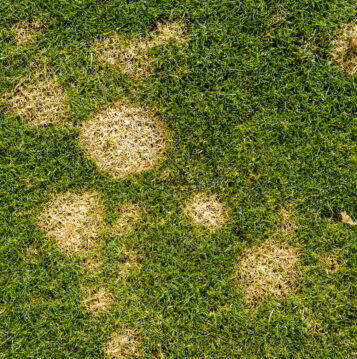How to Identify, Treat & Prevent Common Lawn Diseases?

There’s nothing worse than spending countless hours tending to your lawn only for a disease to ruin all of your hard work.
Joondalup Turf Farm are the epitome of lawn lovers so we can understand how frustrating it would be to labour over your patch of paradise all year long only for an unsightly disease to take hold. This blog post will help you identify the most common lawn diseases, how they can occur, ways to prevent them from infecting your turf and how to treat them.
There are many diseases that can ravish your grass, and most of them are caused by various kinds of fungal strains, either on the plant itself or in the soil. Turf diseases don’t discriminate when it comes to location, as they can be found in most conditions, resulting in both warm and cool season grasses being susceptible.
Which are the most common lawn diseases and how do you identify, prevent and treat them?
Spring Dead Spot
It has been found that intensively managed couch grasses are the most affected by Spring Dead Spot, with the particular pathogen growing more actively in cool, moist conditions. The disease is caused by a soil-borne fungus that infects the roots of the grass plants, causing them to become yellow and stunned. When the temperature is around 15 degrees and the grass is still semi-dormant, this is the most damaging as the pathogen is very active. The first symptoms of the disease appear in lower soil temperatures when growth is slow to dormant and presents as circular, bleached dead patches. These patches range from a few centimetres to over one metre and can reappear in the same spot season after season.
In regard to treating Spring Dead Spot, you should try to address any compaction or waterlogging by aerating your lawn, as well as removing any thatch in order to allow better nutrient uptake and airflow. The preventative application of a broad spectrum fungicide during late summer and autumn can be effective in stopping the return of recurring infections in disease-prone areas. Try to address excessive watering later in the day so that your lawn has a chance to dry out before night falls.
Dollar Spot
Dollar Spot is a fungus with the name that refers to a small, sunken, circular patch that is 1.5 to 5 centimetres in diameter that can appear on the surface of your lawn. These patches can turn from brown to a straw colour and can eventually merge into larger irregular shaped areas and are common in both warm and cool season grasses across Australia.
Dollar Spot usually occurs due to inadequate nutrients in the soil or poor lawn care, such as watering at night, thatch build up, soil compaction and poor drainage. It is more prevalent in autumn and spring throughout warm day temperatures, high humidity and cool nights that produce heavy dews.
Adopting good lawn care practices such as applying adequate fertiliser, reducing thatch levels, aeration, mowing regularly and watering in the morning are all ways to prevent and treat Dollar Spot. Although if the outbreak is severe, you may have to utilise a fungicide.
Brown Patch
Brown patches in lawns are probably one of the most common turf diseases that people can come across. The disease presents in the form of brown discoloured circular patches that vary from a few centimetres to a metre in diameter. These circular patches also sometimes have a smoke ring of mycelium around the edges that appear like a thin brown border. Although it should be noted that the symptoms of Brown Patch can be different depending on the grass cultivar, climatic and atmospheric conditions, soil and intensity of the turf grass management. This kind of infestation tends to be more severe when your lawn is cut to a height less than what is recommended for the turf species being grown.
The conditions that lead to Brown Patch include high relative humidity and temperatures of over 28 degrees during the day and over 15 degrees at night. More than 10 hours a day of foliar wetness for several consecutive days and when night temperatures are consistently above 20 degrees with high humidity are also contributing factors that could favour the spread of the disease.
To prevent your lawn from getting this disease you should avoid applying fertilizer that has too much nitrogen throughout summer and early fall as this is when your grass is the most likely to Brown Patch. Reducing extended periods of wetness and dew on your turf is another way to decrease the chances of this disease.
In order to manage Brown Patch once it has taken hold we suggest that you use low to moderate amounts of nitrogen and phosphorus, and a moderate to high amount of potassium. Increasing the height of cutting and air circulation, minimising the amount of shade, irrigating early in the day, improving the drainage of the turf, reducing thatch and removing dew early in the day are all also methods you can use to reduce the spread of the disease. Be sure to avoid nitrogen applications if the disease is active.
Joondalup Turf Farm, your lawn doctor!
Are you currently dealing with the woes of lawn disease? Don’t despair! Joondalup Turf Farm not only offers the best lawn turf varieties in Perth, WA, but can provide you with advice surrounding your lawn care and maintenance.
Regardless of where you’re at in your lawn journey, from preparing for new lawn turf or seeking suggestions on repairment – we’ve got you covered.
We also provide a delivery lawn turf service throughout the Perth metropolitan area, or if you have the means, you can pick up your turf within 1 hour of calling us (depending on stock availability).
Get in contact with us today to chat about anything and everything turf! We’re open 7 days a week for your convenience!

